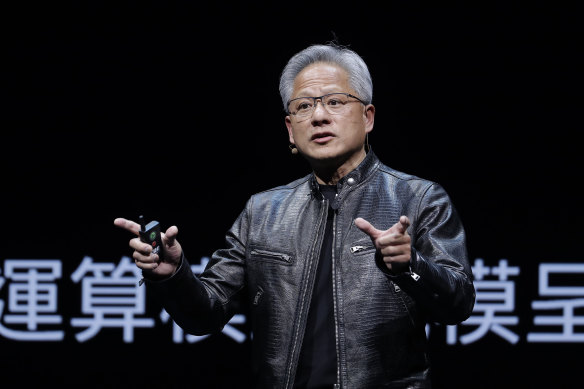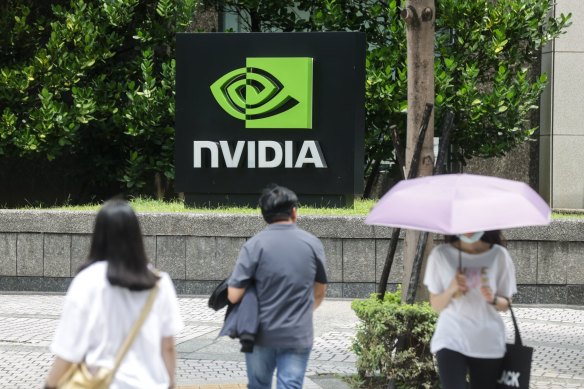Opinion
The $48 billion ‘disappointment’ that sent a shiver through Wall Street
Stephen Bartholomeusz
Senior business columnistThe adage that you can’t please all the people all the time would appear to be the appropriate way to sum up the market’s response to Nvidia’s second-quarter results.
At face value, the chipmaker at the heart of the frenzy of activity and investment in artificial intelligence has produced another spectacular result.

Nvidia CEO Jensen Huang has the company set up for success long into the future.Credit: AP
Its revenue of $US30.04 billion ($44 billion) for the three months was up 15 per cent on its booming first quarter result and 122 per cent above the same quarter last year. That was solidly above the $US28.7 billion consensus forecasts by analysts.
It was, however, the group’s own forecast for third-quarter sales of $US32.5 billion ($47.8 billion) – comfortably above the $US31.9 billion consensus expectation – that disappointed enough investors to see the company’s shares sliding sharply in extended trading. Some (very optimistic, or delusional) analysts were predicting third-quarter sales of almost $US38 billion.
That disappointment came despite a market capitalisation that soared from just under $US400 billion to just over $US3 trillion, after the launch of OpenAI’s ChatGPT in November 2022 ignited the excitement around AI and put a rocket under Nvidia’s share price. The group has consistently outperformed the market’s expectations and its own forecasts.
Apparently this time Nvidia hasn’t signalled that it will outperform the expectations by enough. The market has set a very demanding pass mark for the company.
Nvidia is at the epicentre of the massive investments occurring in AI, dominating the supply of the advanced chips needed to train and deploy the large language models that drive machine learning.
It has also been central to the performance of the overall stock market, now accounting for a remarkable 6 per cent of the S&P 500 after its share price rose almost 240 per cent last year. It has followed that up with another 160 per cent surge so far this year.
It isn’t hyperbole to say that Nvidia’s results are now macro events, akin to a major economic data release or even a Federal Reserve Board statement. It is now the very sensitive barometer for monitoring the development of the AI sector and a key data point for the entire sharemarket.
In the lead-up to what must surely have been one of the most anticipated and important corporate events in years, analysts and investors were looking for the result – and Nvidia’s guidance – for hints that the boom in AI investment might be slowing, and that the capitalisation of the potential of AI in technology companies’ share prices might have been overdone.
Some obviously saw evidence of that in Nvidia’s third-quarter forecast; hence the slide in its price after the result was released.
Nvidia’s performance is being driven by the massive investments in data centres, while a relative handful of mega-techs – Alphabet’s Google, Microsoft, Amazon and Meta Platforms (Facebook’s parent) – scramble to build their AI offerings.
Between them, those companies alone are investing about $US50 billion a quarter, most of it in AI, and the rate of investment is steadily increasing.
The big question mark over those investments is whether they are premature, and therefore whether they will generate returns in future commensurate with the scale of the dollars being sunk in AI today, the AI-swollen share prices of those companies and, of course, their chip supplier.
How that question mark is resolved hinges on when those investments generate material revenues and how big those revenues are, or how much demand there is for AI products in the near term and how transformative it might be in the medium to longer term.
If it turns out that they have invested too much, too early, the hype around AI – and the hyped-up share prices of those most closely associated with the sector – will have proven to be something of a bubble.
Its deflation would be ugly, given the extent to which it has driven markets since ChatGPT’s launch. As a group, Nvidia and its four biggest mega-tech customers have added nearly $US6 trillion of market capitalisation since the ChatGPT launch.
The Nvidia result and forecast don’t answer the big questions overhanging the sector, although the next quarter’s outcome might provide a little more insight into its near-term future.

Wall Street has set a very demanding pass mark for Nvidia. Credit: Bloomberg
The only glitch in Nvidia’s recent remarkable performance has been the delayed rollout of its next-generation chip, dubbed Blackwell.
The production schedule for the chip has been pushed back by some issues with its design and the Taiwan Semiconductor Manufacturing Company’s ability to manufacture the chips, which are more powerful and energy-efficient than the existing H100 chips.
According to the company’s founder and chief executive, Jensen Huang, the Blackwell chips are between seven and 30 times faster than the H100 and 25 times more energy efficient.
The production issues appear to have been resolved, with Huang saying there is “incredible” anticipation of its availability and the company saying it is expected to generate “several billions” from its sales in its fourth quarter.
With no real competitors, yet – there’s a horde of comparatively small companies aspiring to compete with their own chips – Nvidia is guaranteed to generate continued strong growth, given the rate at which the mega-techs are scrambling to invest in what’s developed into the biggest tech-related “land grab” of the century so far.
It’s also highly profitable growth, with second-quarter earnings up 168 per cent to $US16.6 billion ($US6.2 billion in the same quarter of last year). Its gross margin of 75.7 per cent reflects the dominance it gained by being the first mover in the manufacturing of the chips required for AI and the surplus of demand for its chips over its capacity to supply them.
That reliance on AI to rationalise a share price that’s so laden with optimism that even outperforming market expectations isn’t enough to satisfy investors also points to Nvidia’s vulnerability.
Its value and, to varying degrees, those of the mega-techs it supplies, is reliant on the excitement around AI developing into a long-running boom, not a lucrative but short-lived bubble.
The Market Recap newsletter is a wrap of the day’s trading. Get it each weekday afternoon.